Introduction
The legal industry, traditionally known for its reliance on precedent and meticulous processes, is undergoing a significant transformation. Artificial Intelligence (AI) is at the forefront of this change, offering tools that enhance efficiency, accuracy, and decision-making. From automating routine tasks to providing predictive analytics, AI is reshaping how legal professionals operate.
What is AI and Why Does It Matter in Law?
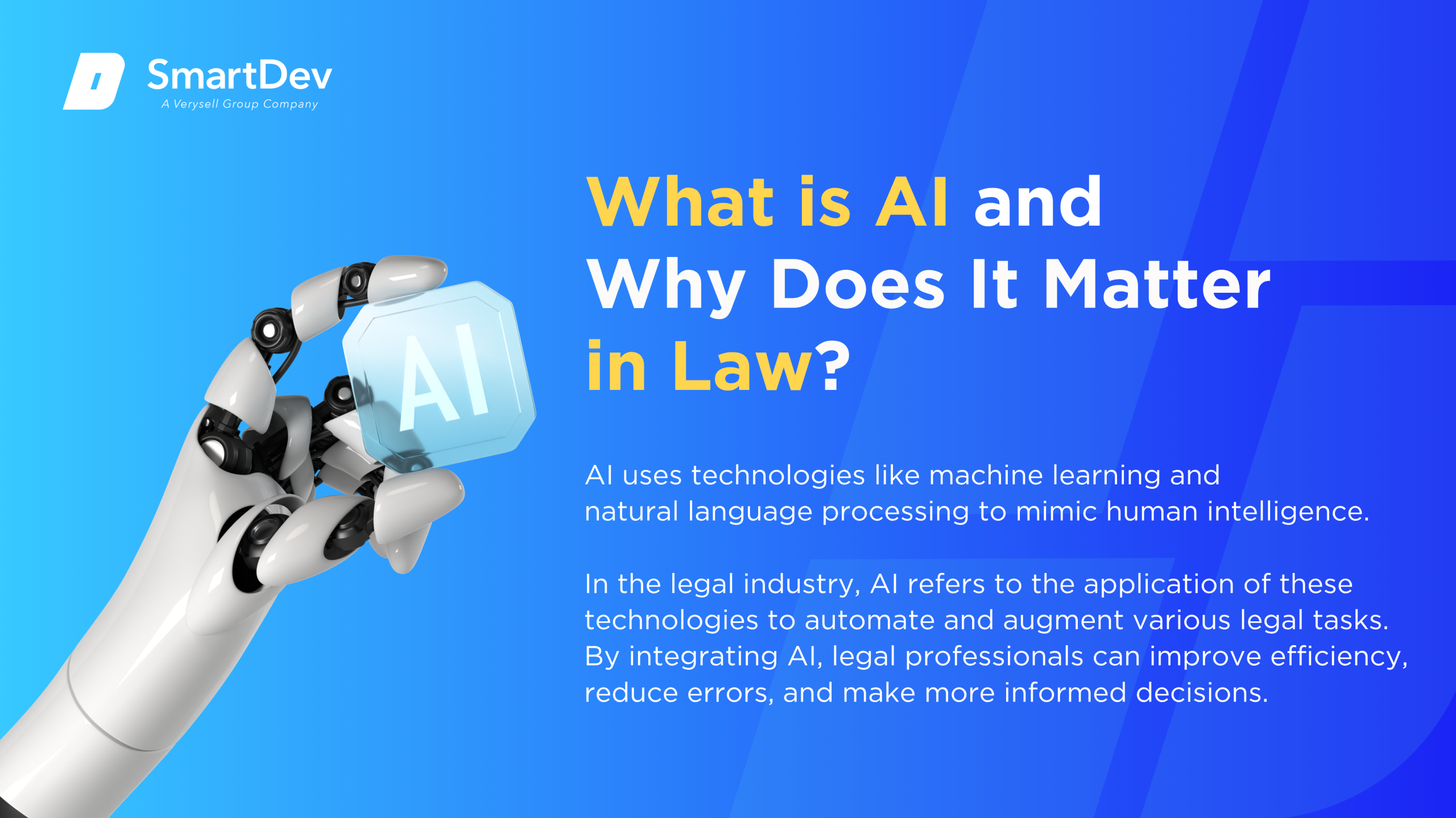
Definition of AI and Its Core Technologies
Artificial Intelligence (AI) encompasses computer systems designed to perform tasks that typically require human intelligence, such as learning, reasoning, and problem-solving. Key technologies under the AI umbrella include Machine Learning (ML), which enables systems to learn from data; Natural Language Processing (NLP), allowing machines to understand and interpret human language; and Computer Vision, which enables the interpretation of visual information.
In the legal industry, AI refers to the application of these technologies to automate and augment various legal tasks. This includes automating document review, enhancing legal research through intelligent search algorithms, and predicting case outcomes using data analytics. By integrating AI, legal professionals can improve efficiency, reduce errors, and make more informed decisions.
The Growing Role of AI in Transforming Law
AI is revolutionizing legal operations by automating time-consuming tasks, allowing lawyers to focus on more strategic activities. For instance, AI-powered tools can quickly sift through vast amounts of legal documents to identify relevant information, significantly reducing the time spent on document review.
Moreover, AI enhances decision-making by providing predictive analytics. By analyzing historical case data, AI can forecast potential outcomes, aiding lawyers in strategy development and risk assessment.
Innovation in legal services is also being driven by AI. Firms are developing AI-driven platforms that offer clients more accessible and efficient legal solutions, such as virtual legal assistants and automated contract analysis tools.
Key Statistics and Trends Highlighting AI Adoption in Law
The adoption of AI in the legal sector is accelerating. According to a 2025 report by Thomson Reuters, 79% of legal professionals now incorporate AI tools into their daily work, a significant increase from 19% in 2023. This surge reflects the growing recognition of AI’s value in enhancing legal practice.
Furthermore, a study by the American Bar Association found that AI adoption within the legal profession nearly tripled year over year, from 11% in 2023 to 30% in 2024. This growth spans firms of all sizes, indicating a broad-based embrace of AI technologies across the industry.
Business Benefits of AI in Law
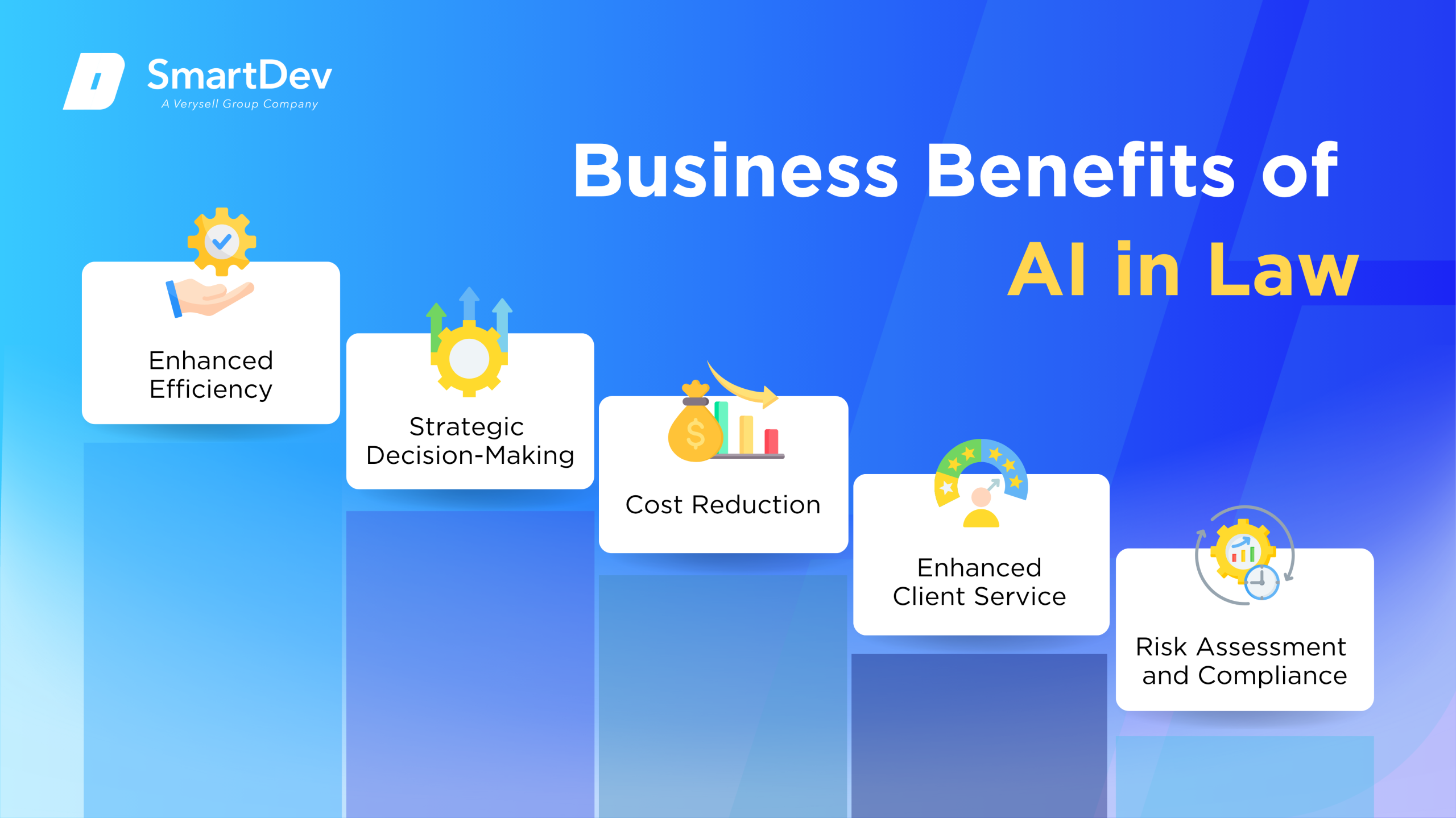
1. Enhanced Efficiency
AI significantly enhances operational efficiency by automating routine legal tasks that traditionally consume valuable time. Activities like legal research, contract analysis, and document review can now be completed in minutes with AI tools trained to process legal language at scale. This allows legal teams to focus on high-value work such as client strategy, litigation planning, and advisory services.
These automation gains also reduce the risk of oversight and human error. AI systems can quickly detect missing clauses or identify relevant case law with high precision across large data sets. As a result, legal workflows become faster, more accurate, and better equipped to meet the demands of fast-paced or high-volume cases.
2. Strategic Decision-Making
AI empowers legal professionals to make more informed decisions by analyzing patterns from historical legal data. With access to predictive analytics, lawyers can better anticipate case outcomes, understand judicial behavior, and fine-tune litigation strategies. This turns legal planning into a data-backed discipline rather than relying solely on intuition or past experience.
Beyond courtroom strategy, AI also enhances compliance and corporate advisory work. By continuously scanning for regulatory shifts and legal trends, it helps legal teams foresee potential risks and adjust early. This proactive intelligence elevates the role of legal counsel from reactive problem-solver to strategic business advisor.
3. Cost Reduction
AI reduces operational costs by automating labor-intensive legal processes such as contract review and document drafting. This lowers dependency on large support teams and enables firms to scale operations without proportional increases in headcount.
For firms with fixed-fee arrangements or heavy caseloads, AI ensures sustainable service delivery. It reallocates human talent to complex, strategic matters—boosting both efficiency and profitability.
4. Enhanced Client Service
AI-driven tools improve client engagement by offering faster communication and better visibility into case progress. Features like virtual legal assistants and automated status updates ensure clients stay informed and feel supported throughout their legal matters. This enhanced responsiveness helps build lasting trust and client satisfaction.
Clients also benefit from consistent, high-quality legal deliverables. AI ensures that each document review, risk analysis, or compliance check follows the same rigorous process. This consistency strengthens a firm’s reputation for professionalism and reliability—key factors in client retention and growth.
5. Risk Assessment and Compliance
AI strengthens legal risk management by continuously monitoring updates in laws, regulations, and judicial decisions. Using advanced language processing, it can flag emerging compliance issues relevant to a firm’s practice or client base. This early detection helps legal teams act swiftly, reducing the risk of non-compliance and regulatory penalties.
It also improves internal document oversight by identifying vague language, missing terms, or unusual clauses that may pose future legal risks. By surfacing these issues before contracts are signed or cases proceed, lawyers can take corrective action proactively. This kind of risk intelligence is especially critical in highly regulated or fast-changing sectors.
Challenges Facing AI Adoption in Law
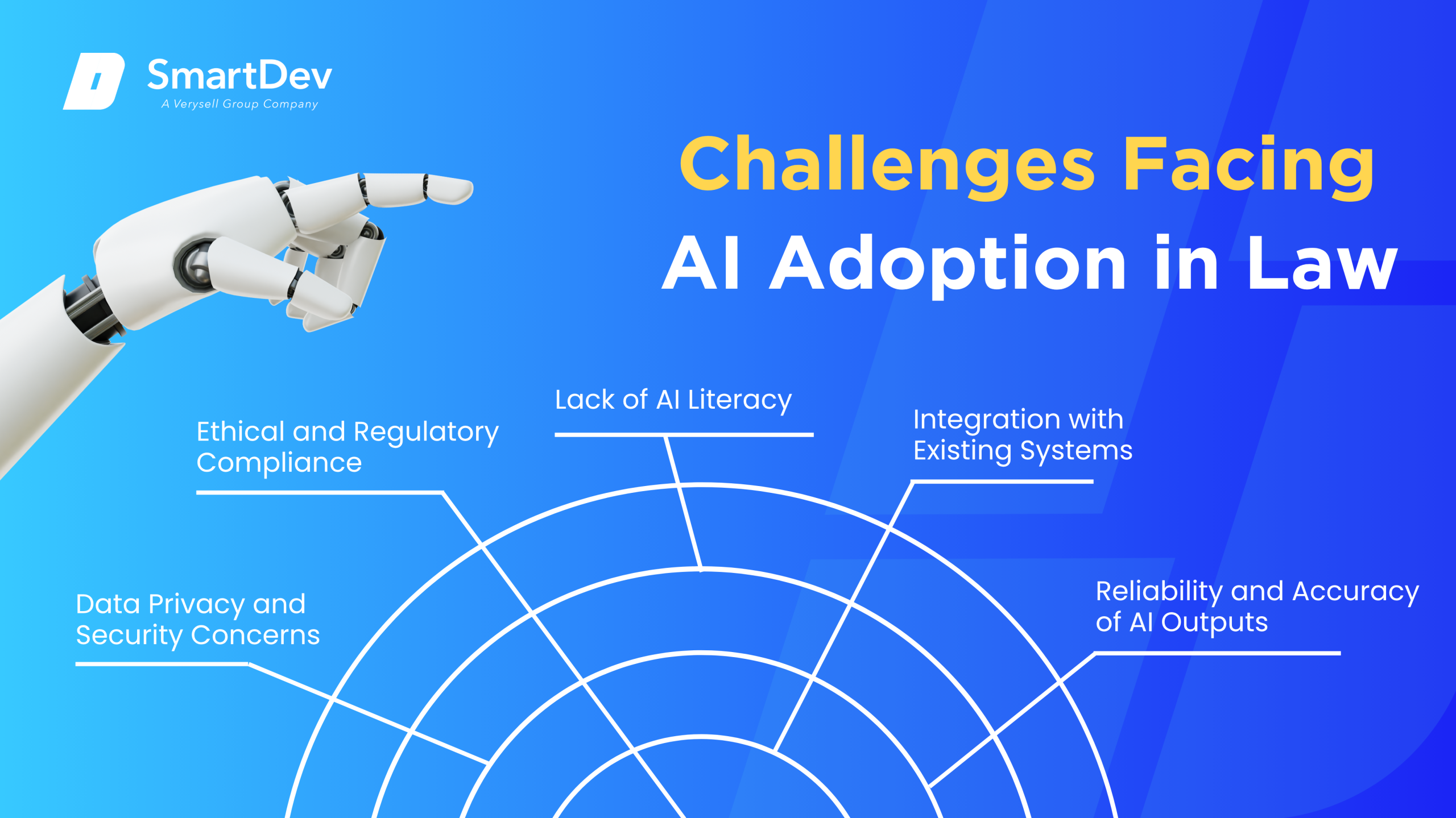
1. Data Privacy and Security Concerns
Law firms deal with sensitive client data, making privacy a major barrier to AI adoption. AI tools often require processing confidential information, raising risks of data breaches and unauthorized access. Without strong security measures, firms face legal and reputational consequences.
Ensuring AI platforms meet legal industry standards is critical. Cloud-based systems must be properly secured to prevent vulnerabilities. Firms need robust encryption, access controls, and compliance with regulations like GDPR to safely implement AI.
For a deeper look at how businesses can navigate the balance between innovation and information protection, explore our insights on AI and Data Privacy.
2. Ethical and Regulatory Compliance
AI raises ethical concerns about fairness, bias, and accountability in legal work. Tools trained on historical data may reinforce systemic biases, potentially skewing outcomes. This challenges the legal profession’s duty to uphold impartiality and justice.
To dive deeper into how organizations can mitigate bias and uphold ethical standards in AI systems, check out our guide on addressing AI bias and fairness.
Regulatory compliance is also evolving as AI becomes more common in legal practice. Firms must stay ahead of guidance from bar associations and regulators. Maintaining ethical standards means regularly auditing how AI is used and ensuring transparency in its decisions.
3. Lack of AI Literacy
Many legal professionals lack the technical background to confidently evaluate or apply AI tools. Without understanding how AI works, there’s a risk of misuse or underutilization. This slows adoption and can lead to skepticism or blind reliance on AI outputs.
Closing this knowledge gap requires targeted training across roles. Lawyers need to learn when and how to use AI effectively, not just how to operate tools. Building this literacy is key to adopting AI responsibly and strategically.
4. Integration with Existing Systems
Law firms often operate with outdated or disconnected systems that are incompatible with modern AI tools. Integrating AI requires clean, structured data, which many firms lack. Poor data quality can undermine AI effectiveness and lead to unreliable outputs.
Successful integration demands both technical upgrades and cross-functional collaboration. Data must be standardized and systems must be able to “talk” to each other. For firms with limited IT capacity, this can be a significant barrier.
5. Reliability and Accuracy of AI Outputs
AI is not infallible; tools can generate errors or “hallucinations” if based on flawed or biased data. Inaccurate legal recommendations or fictitious case citations can jeopardize client trust and legal outcomes. Accuracy remains non-negotiable in legal practice.
To manage this, AI must be used as a support tool, not a final authority. Legal experts must validate outputs before relying on them in practice. Establishing review processes ensures AI adds value without compromising standards.
Specific Applications of AI in Law
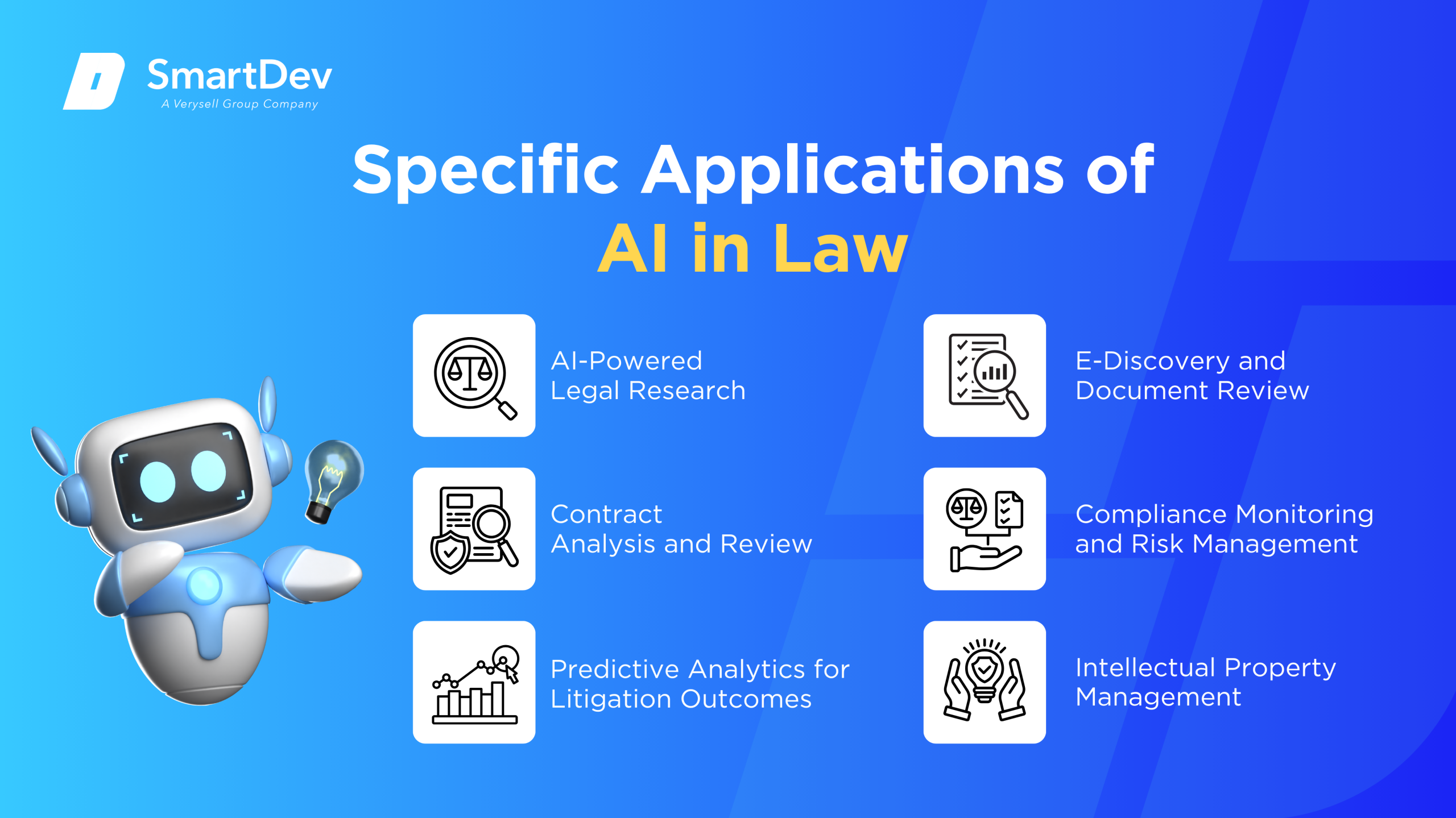
1. AI-Powered Legal Research
Legal research is a critical function in the practice of law, traditionally requiring significant time and effort to analyze statutes, precedents, and case law. AI-driven tools enhance this process by rapidly scanning vast legal databases to surface the most relevant information. These tools significantly reduce the research burden, improving both efficiency and accuracy.
These systems employ natural language processing (NLP) and machine learning to interpret complex legal queries and identify pertinent legal sources. By recognizing linguistic patterns and contextual relevance, they deliver highly precise results. Integration with existing legal databases ensures seamless workflow compatibility.
The strategic advantage of AI in legal research lies in its ability to minimize the risk of oversight while enabling legal professionals to focus on higher-order tasks. Enhanced speed and comprehensiveness allow firms to deliver superior legal services. Additionally, the automation of repetitive processes contributes to significant cost savings.
Real-World Example:
LexisNexis uses AI through its Lexis+ platform to support legal research and smart search capabilities. This AI integration allows law firms to quickly retrieve relevant statutes and case law with higher precision. Firms using Lexis+ have reported substantial reductions in research time and improvements in legal accuracy.
2. Contract Analysis and Review
Contracts form the backbone of business transactions and legal operations, but manual review is time-intensive and error-prone. AI automates this task by identifying key terms, potential risks, and compliance issues within documents. This shift reduces human error and accelerates turnaround times.
AI tools leverage NLP to interpret legal language and use machine learning to detect patterns across contracts. They highlight anomalies, assess risk, and ensure consistency across documentation. Integration with document management systems further enhances operational efficiency.
By enabling faster and more accurate contract review, AI supports due diligence, risk management, and regulatory compliance. Legal teams can allocate resources to strategic initiatives, increasing value delivery. The consistency and objectivity of AI-based reviews also enhance client confidence.
Real-World Example:
LawGeex provides an AI contract review platform used by major enterprises like eBay and HP. Benchmark studies showed LawGeex reviewed NDAs faster and more accurately than legal professionals. These companies significantly reduced contract turnaround time and minimized legal risk.
3. Predictive Analytics for Litigation Outcomes
Predictive analytics empowers legal professionals by offering data-driven insights into potential case outcomes. By analyzing historical data such as judicial decisions, legal filings, and case characteristics, AI models can forecast likely rulings. This predictive power informs litigation strategy and resource allocation.
The technology relies on vast datasets to train machine learning models that recognize patterns affecting case results. Variables such as judge behavior, jurisdiction, and legal arguments are quantified to produce statistically grounded predictions. The outputs aid lawyers in risk assessment and decision-making.
Strategically, predictive analytics enhances confidence in legal decisions and optimizes litigation planning. Firms can better advise clients, allocate resources more effectively, and pursue favorable settlements. These insights also support competitive differentiation in a crowded legal market.
Real-World Example:
Premonition AI provides predictive litigation analytics used by insurers and law firms to assess courtroom risks. The platform helps identify which attorneys are most successful before specific judges. Users have reported more informed litigation strategies and higher success rates in court.
4. E-Discovery and Document Review
E-discovery is an essential but resource-heavy phase of litigation involving the identification and analysis of electronic documents. AI automates document classification and relevance assessment, significantly expediting the review process. This approach ensures accuracy while managing voluminous datasets.
AI platforms utilize machine learning to flag critical information, cluster documents by relevance, and reduce redundancies. These systems adapt and improve with exposure to more data, enhancing review precision over time. Integration with e-discovery platforms enables seamless adoption.
The operational benefits include faster case preparation, reduced review costs, and lower error rates. Legal teams gain the capacity to handle complex cases with large volumes of digital evidence. Furthermore, AI fosters greater transparency and accountability in discovery processes.
Real-World Example:
Relativity Trace is widely used by firms like Clifford Chance to accelerate e-discovery. By applying AI to classify and review documents, they process thousands per hour with high accuracy. This use of AI cut discovery costs and drastically shortened litigation preparation timelines.
5. Compliance Monitoring and Risk Management
Compliance is a cornerstone of legal and corporate governance, requiring constant vigilance. AI facilitates real-time compliance monitoring by analyzing communications, transactions, and operational behaviors. The goal is to detect potential violations proactively.
Using machine learning, AI identifies anomalies that could indicate non-compliant behavior. It flags irregularities in processes, documents, and employee actions for review. This automation enables rapid response and continuous oversight.
Proactively managing compliance reduces the likelihood of regulatory breaches and associated penalties. It also promotes a culture of integrity and transparency. AI-powered systems offer scalability and consistency that manual approaches cannot match.
Real-World Example:
Smokeball integrates AI-driven compliance features into its legal practice management software. Firms use it to monitor workflows and ensure industry-specific regulatory compliance. These tools have improved audit readiness and minimized non-compliance risks.
6. Intellectual Property Management
Intellectual property (IP) is a critical asset that requires active management and protection. AI supports this by automating IP monitoring, portfolio tracking, and infringement detection. These functions safeguard innovations and business interests.
AI systems analyze patent databases, monitor competitors, and assess portfolio strengths. By identifying trends and risks, they enable strategic IP decisions. Integration with legal systems ensures timely alerts and reporting.
Effective IP management with AI reduces administrative burdens and enhances strategic foresight. It allows legal teams to focus on value-added activities and protect competitive advantage. Automation ensures no detail is overlooked.
Real-World Example:
PatSnap is widely used by companies like IBM to manage large-scale IP portfolios. It provides AI-powered analytics for patent valuation and competitor tracking. Users benefit from more efficient IP strategy and reduced exposure to infringement risks.
Examples of AI in Law
Real-World Case Studies
The integration of AI into legal practice is no longer speculative but proven through tangible implementations. These examples demonstrate how law firms are leveraging AI to improve productivity, reduce costs, and enhance legal outcomes. The case studies that follow illustrate AI’s impact across various legal functions.
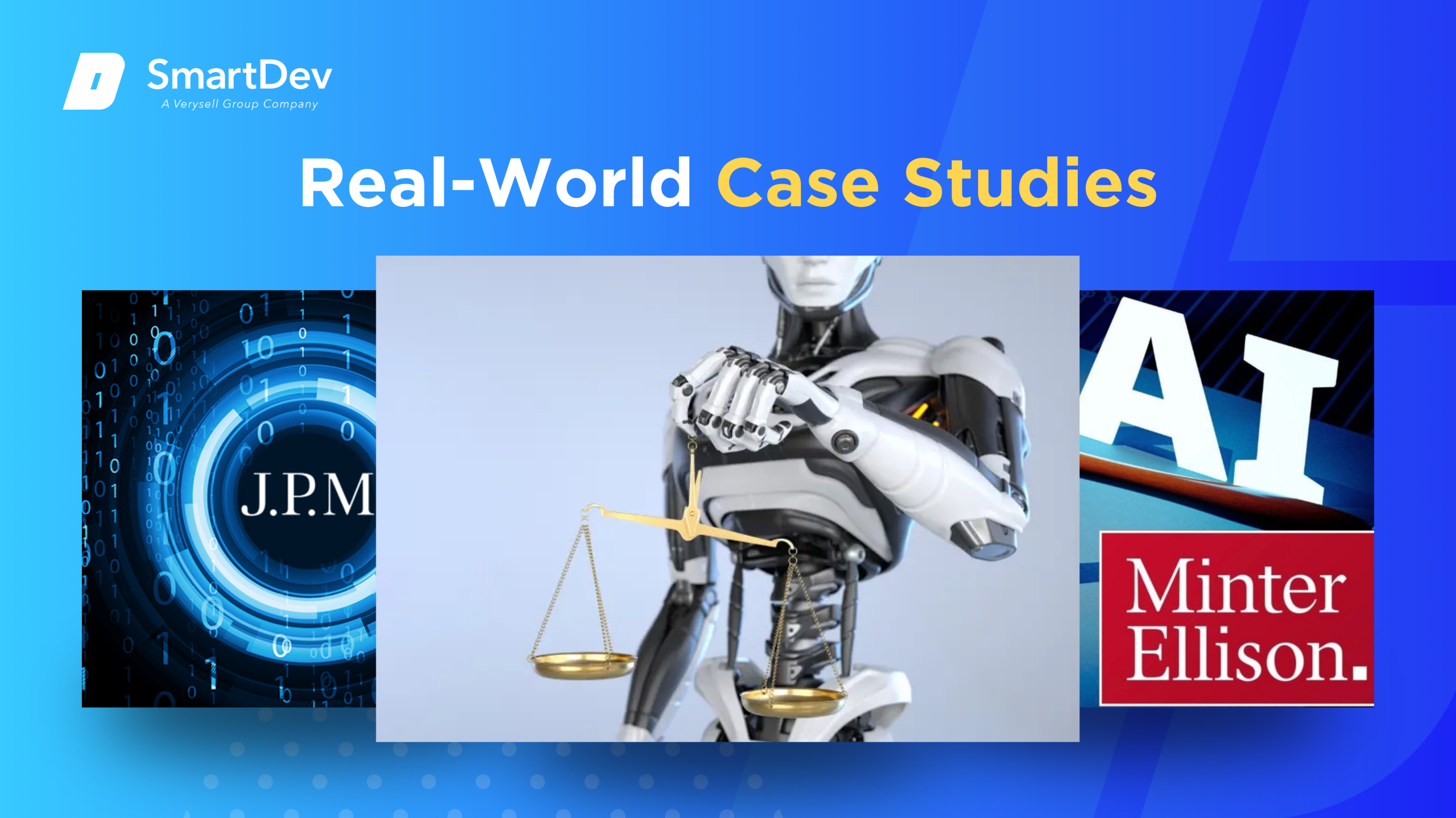
1. BakerHostetler: Enhancing Legal Research with ROSS Intelligence
BakerHostetler adopted ROSS Intelligence to optimize legal research capabilities using AI. ROSS uses NLP to interpret queries and retrieve highly relevant case law. This significantly reduced research time and improved legal accuracy.
By implementing this tool, the firm accelerated information retrieval and freed up attorney time for client-facing tasks. Legal teams benefited from increased productivity and strategic focus. ROSS Intelligence enabled a 60% reduction in research-related hours.
2. JPMorgan Chase: Automating Contract Review with COIN
JPMorgan Chase created the COIN platform to streamline contract analysis. The system applies machine learning to interpret commercial loan agreements and extract key obligations. It replaced hundreds of thousands of hours of legal review annually.
The efficiency gain resulted in faster contract turnaround and enhanced accuracy. COIN reduced review time from 360,000 hours to seconds. This transformed contract operations and minimized legal overhead.
3. MinterEllison: Accelerating E-Discovery Processes
MinterEllison used AI tools to manage a high-volume legal discovery project. The platform reviewed thousands of documents per hour, far exceeding manual capacity. This enabled the firm to handle large datasets with precision and speed.
As a result, the firm improved cost-efficiency while maintaining quality standards. AI-powered discovery facilitated better case preparation and resource allocation. The solution demonstrated the practical value of AI in complex litigation.
Innovative AI Solutions

The legal industry is embracing a wave of AI innovation that is redefining traditional legal tasks. One notable advancement is the use of generative AI to draft contracts, legal briefs, and other documents with speed and accuracy. By generating context-aware and legally sound text, these models support faster document creation and significantly reduce the chances of drafting errors.
Another transformative development is the application of AI-powered legal analytics. These tools analyze data from court rulings, filings, and legal proceedings to uncover patterns and predict outcomes. Legal teams use these insights to tailor case strategies, evaluate litigation risk, and improve performance across a range of legal operations.
AI is also reshaping legal education and training by introducing interactive, adaptive learning experiences. These platforms simulate real-world legal scenarios and provide tailored feedback to learners, helping bridge the gap between academic theory and legal practice. As a result, law students and professionals develop critical, practice-ready skills in a flexible and technology-integrated learning environment.
AI-Driven Innovations Transforming Law
Emerging Technologies in AI for Law
Artificial Intelligence (AI) is revolutionizing the legal industry by automating routine tasks, enhancing decision-making, and improving efficiency. Generative AI, in particular, is making significant strides in legal research and document drafting. Tools are enabling law firms to accelerate legal research and drafting processes.
Computer vision is also being utilized for visual data analysis in legal contexts. For instance, AI-powered tools can analyze surveillance footage to identify relevant events or individuals, aiding in evidence gathering and case preparation. These technologies are streamlining workflows and allowing legal professionals to focus on more strategic tasks.
Another emerging area is the convergence of AI and blockchain, which opens possibilities for secure smart contracts, immutable audit trails, and tamper-proof evidence management. To explore these innovations, check out our article on AI and Blockchain.
AI’s Role in Sustainability Efforts
AI is playing a crucial role in promoting sustainability within the legal sector. By reducing the need for physical documents through digitalization and automating processes, AI helps decrease paper usage and energy consumption. Predictive analytics can also assist law firms in optimizing resource allocation, leading to more sustainable operations.
Moreover, AI-driven tools can analyze large datasets to identify patterns and trends related to environmental regulations and compliance. This enables legal professionals to provide more informed advice to clients on sustainability-related matters, further contributing to environmental conservation efforts.
How to Implement AI in Law
Implementing AI in the legal field is more than just adopting new technologies; it’s about reshaping how your firm delivers value. Achieving success starts with a clear strategy that aligns people, processes, and data to unlock AI’s full potential.
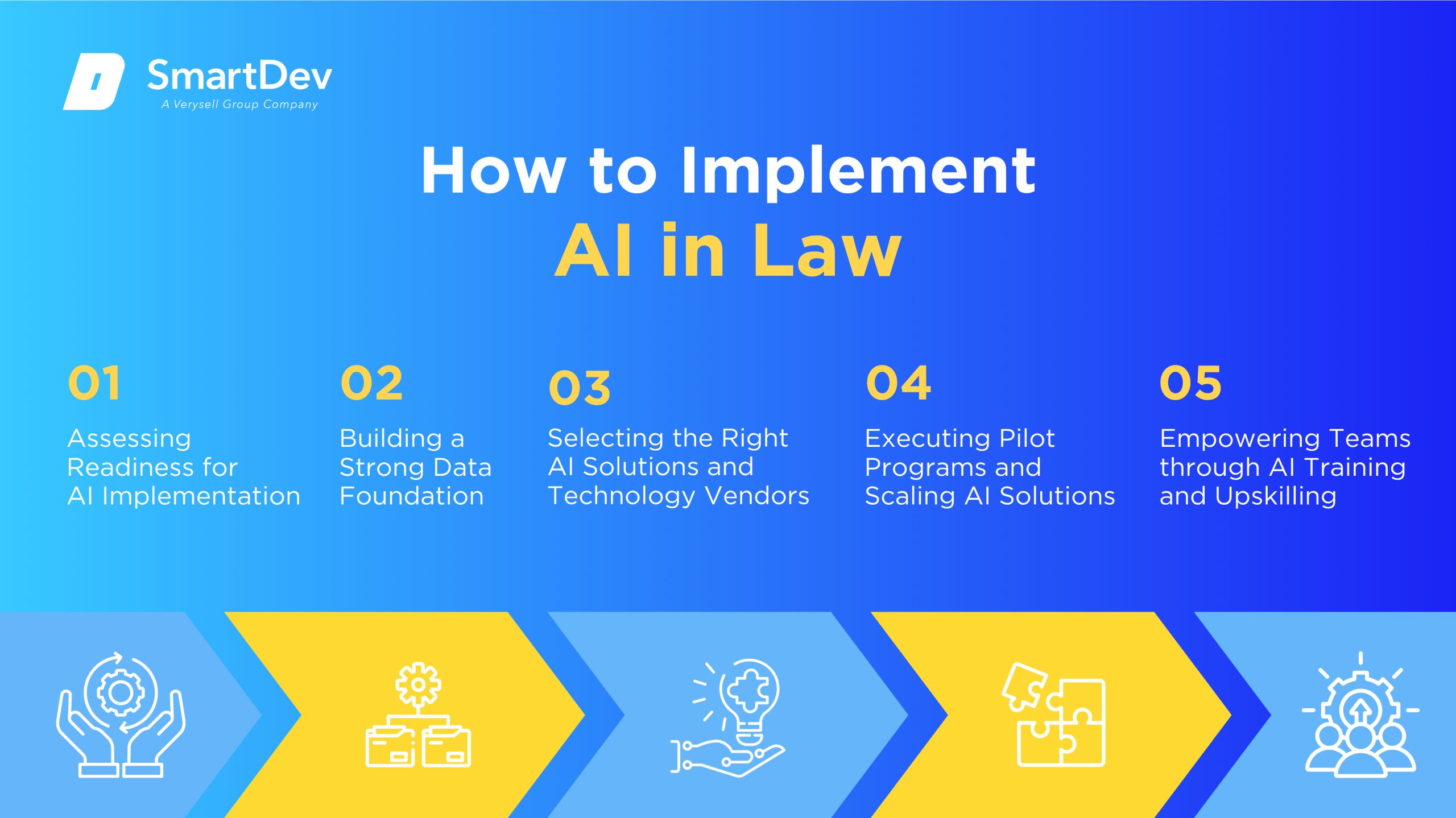
Step 1. Assessing Readiness for AI Adoption
Before integrating AI into legal practices, it’s essential to assess the firm’s readiness for adoption. This involves evaluating current workflows, identifying areas where AI can add value, and determining the necessary infrastructure and resources. Engaging stakeholders and securing their buy-in is also critical to ensure a smooth transition.
Identifying business areas suitable for AI integration is a key step. Tasks that are repetitive, time-consuming, and data-intensive, such as document review and legal research, are prime candidates for automation. By focusing on these areas, firms can maximize the benefits of AI implementation.
Step 2. Building a Strong Data Foundation
A robust data foundation is vital for successful AI integration. This includes establishing processes for data collection, cleaning, and management to ensure the quality and reliability of information used by AI systems. Implementing data governance policies and ensuring compliance with privacy regulations are also essential.
Investing in data infrastructure, such as secure storage solutions and data analytics platforms, can further enhance the effectiveness of AI tools. By maintaining high-quality data, law firms can improve the accuracy and efficiency of AI-driven processes.
Step 3. Choosing the Right Tools and Vendors
Selecting appropriate AI tools and vendors is crucial for successful implementation. Firms should evaluate AI platforms based on their specific needs, scalability, ease of integration, and vendor support. Conducting pilot tests and seeking feedback from users can help in making informed decisions.
It’s also important to consider the vendor’s reputation, experience in the legal industry, and commitment to data security. Establishing clear communication channels and service level agreements can ensure a productive partnership and smooth deployment of AI solutions.
Step 4. Pilot Testing and Scaling Up
Implementing AI should begin with pilot testing in selected areas to evaluate performance and identify potential issues. This allows firms to make necessary adjustments before full-scale deployment. Monitoring key performance indicators (KPIs) during the pilot phase can provide insights into the effectiveness of AI tools.
Once the pilot is successful, firms can gradually scale up AI implementation across other areas. Continuous evaluation and optimization are essential to ensure that AI solutions continue to meet the firm’s evolving needs and deliver the desired outcomes.
Step 5. Training Teams for Successful Implementation
Training employees to work alongside AI technologies is vital for successful adoption. This includes providing education on AI capabilities, limitations, and best practices. Encouraging a culture of continuous learning and innovation can help teams adapt to new technologies more effectively.
Upskilling staff not only enhances their ability to leverage AI tools but also alleviates concerns about job displacement. By emphasizing the collaborative nature of AI and human expertise, firms can foster a positive environment that embraces technological advancements.
Measuring the ROI of AI in Law
Key Metrics to Track Success
Measuring the return on investment (ROI) of AI in legal practices involves tracking various metrics. Productivity improvements can be assessed by evaluating the time saved on tasks such as document review and legal research. Cost savings achieved through automation can be quantified by comparing expenses before and after AI implementation.
Other important metrics include the accuracy and consistency of AI-generated outputs, client satisfaction levels, and the impact on case outcomes. By analyzing these indicators, firms can determine the effectiveness of AI tools and make data-driven decisions for future investments.
Case Studies Demonstrating ROI
Several law firms have reported significant ROI from AI adoption. For example, Integreon assisted a ride-sharing company in migrating metadata from over 3,000 contracts to a new contract lifecycle management system, achieving an estimated 80% reduction in labor costs and a 60%-80% savings in time. This demonstrates the potential of AI to streamline complex legal processes and deliver substantial cost savings.
Another case involves Lexis+ AI, which delivered a 344% ROI and saved over 20,000 attorney hours in three years for large law firms. These examples highlight the tangible benefits of AI in enhancing efficiency and profitability in legal practices.
Common Pitfalls and How to Avoid Them
Despite the advantages, there are pitfalls to avoid when implementing AI in law. One common issue is overreliance on AI-generated outputs without proper verification, leading to errors and potential legal consequences. To mitigate this risk, firms should establish rigorous review processes and ensure human oversight of AI activities.
Another challenge is inadequate training and change management, which can hinder adoption and limit the effectiveness of AI tools. Investing in comprehensive training programs and fostering a culture that embraces innovation are essential for successful AI integration.
Future Trends of AI in Law
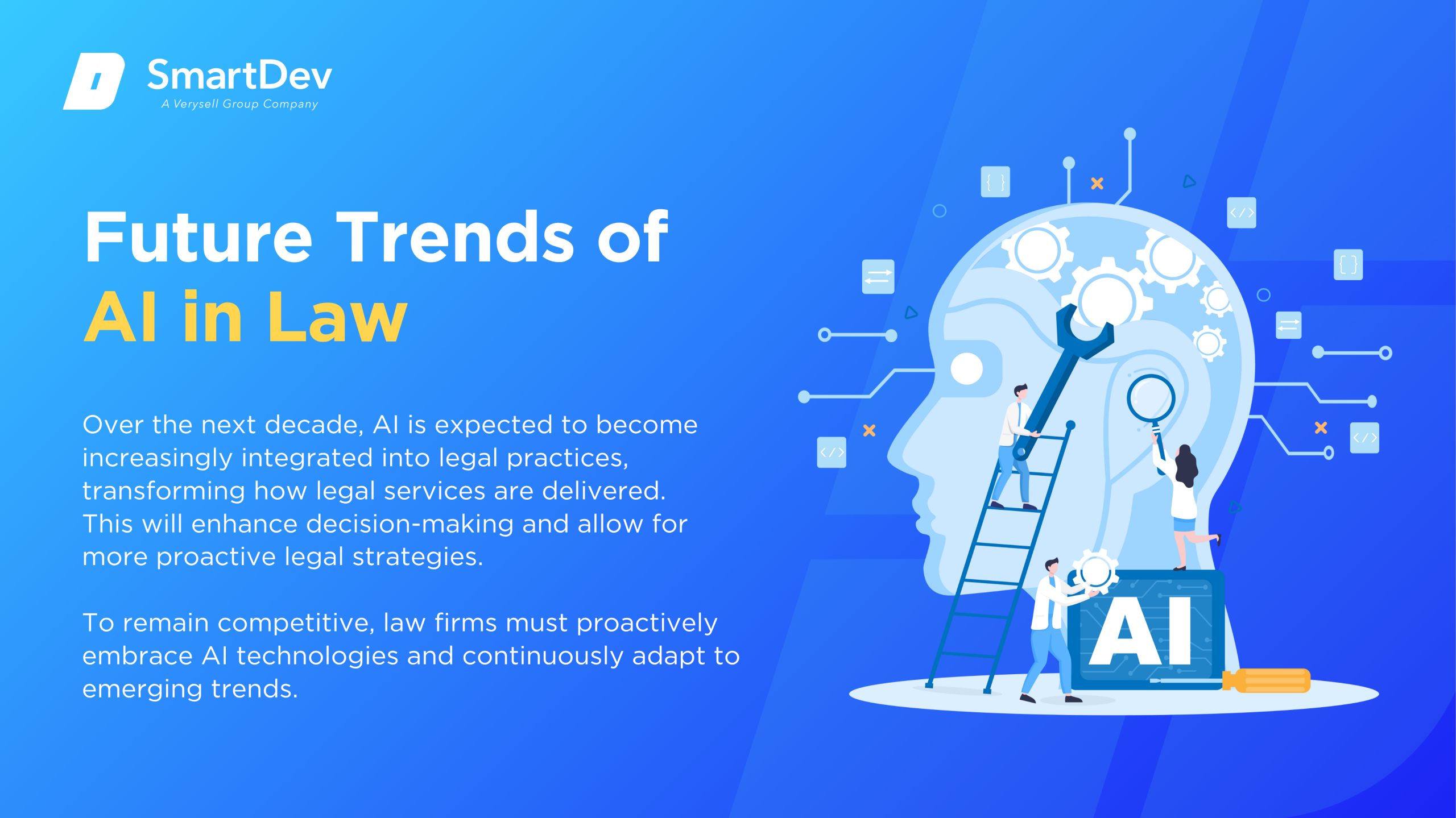
Predictions for the Next Decade
Over the next decade, AI is expected to become increasingly integrated into legal practices, transforming how legal services are delivered. Advancements in natural language processing and machine learning will enable AI to handle more complex tasks, such as legal reasoning and predictive analytics. This will enhance decision-making and allow for more proactive legal strategies.
Additionally, the development of AI-powered tools tailored to specific legal domains, such as intellectual property and environmental law, will provide specialized support and improve efficiency. As AI continues to evolve, it will play a pivotal role in shaping the future of the legal industry.
How Businesses Can Stay Ahead of the Curve
To remain competitive, law firms must proactively embrace AI technologies and continuously adapt to emerging trends. This involves staying informed about the latest developments, investing in research and development, and fostering partnerships with technology providers. By doing so, firms can leverage AI to enhance their services and deliver greater value to clients.
Moreover, cultivating a culture of innovation and agility will enable firms to respond effectively to changes in the legal landscape. Encouraging collaboration between legal professionals and technologists can drive the development of customized AI solutions that address specific challenges and opportunities within the firm.
Conclusion
Key Takeaways
AI is transforming the legal industry by automating routine tasks, enhancing decision-making, and improving efficiency. Key use cases include legal research, document review, contract analysis, and predictive analytics.
Successful AI implementation requires assessing readiness, building a strong data foundation, selecting appropriate tools, conducting pilot tests, and training teams. Measuring ROI through productivity gains, cost savings, and improved outcomes is essential to evaluate the effectiveness of AI initiatives.
Moving Forward: A Path to Progress
As AI reshapes the legal landscape, law firms and legal departments have a rare opportunity to elevate efficiency, reduce operational overhead, and deliver sharper, more strategic counsel. By strategically integrating AI, you can automate labor-intensive tasks like contract review, due diligence, and legal research, freeing your team to focus on high-value client work.
At SmartDev, we empower legal teams with custom-built AI solutions designed to enhance accuracy, speed, and client outcomes. Whether you’re exploring generative AI for document drafting or predictive analytics for litigation strategy, our experts work closely with you to ensure a seamless and secure AI adoption tailored to your unique legal workflows.
Contact us today to discover how AI can future-proof your practice, optimize your caseload management, and position your firm as a leader in digital legal innovation.
Reach out today to start building a smarter, more agile legal operation.
—
References:
- Legal AI: Transforming the Legal Profession with Cutting-Edge Technology | Medium
- How AI is transforming the legal profession (2025) | Thomson Reuters
- AI adds bespoke features to ready-made tools | Financial Times
- ABA Tech Survey Finds Growing Adoption of AI in Legal Practice, with Efficiency Gains as Primary Driver | LawSites
- Fake cases, judges’ headaches and new limits: Australian courts grapple with lawyers using AI | The Guardian
- Trouble with AI ‘hallucinations’ spreads to big law firms | Reuters
- Generative AI for legal professionals: Top use cases | Thomson Reuters
- 2024 Artificial Intelligence TechReport | American Bar Association
- Justice Meets Algorithms: The Rise of Gen AI in Law Firms | New York State Bar Association
- Top 15 Real-Life Use Cases For AI In the Legal Industry | Redress Compliance
- Gen AI Case Studies and Real-World Examples: Case Preparation and Strategy | Practising Law Institute







